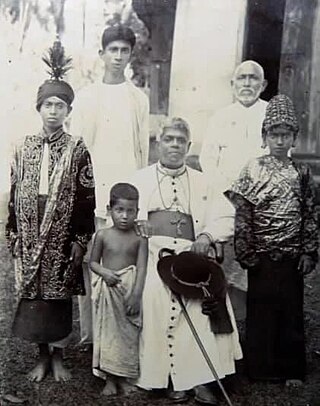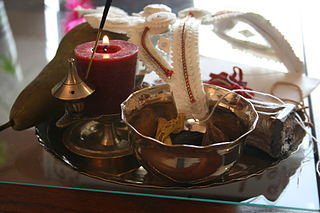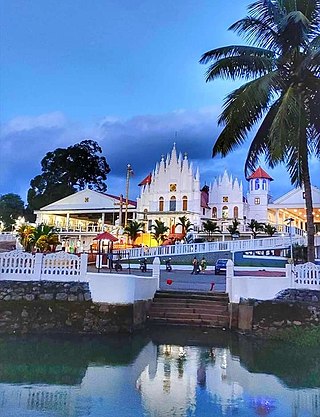Indian cuisine consists of a variety of regional and traditional cuisines native to the Indian subcontinent. Given the diversity in soil, climate, culture, ethnic groups, and occupations, these cuisines vary substantially and use locally available spices, herbs, vegetables, and fruits.

Vishu is a Hindu festival celebrating the Malayali New Year in Kerala, Tulu Nadu, and Mahe of India. Vishu falls on the first day of the month of Medam in the Malayalam Calendar. It is the traditional new year, while the Kollam era calendar new year falls on the 1st Chingham.

The K'nānāya, also known as the Southists or Tekkumbhagar, are an endogamous ethnic group found among the Saint Thomas Christian community of Kerala, India. They are differentiated from another part of the community, known in this context as the Northists (Vaddakkumbhagar). There are about 300,000 Knanaya in India and elsewhere.

Sadya is a meal of Kerala origin and of importance to all Malayalis, consisting of a variety of traditional vegetarian dishes usually served on a banana leaf in Kerala as lunch. Sadya means banquet in Malayalam. Sadya is typically served as a traditional feast for Onam, the state festival of Kerala and Vishu.

Assamese cuisine is the cuisine of the Indian state of Assam. It is a style of cooking that is a confluence of cooking habits of the hills that favour fermentation and drying as forms of preservation and those from the plains that provide extremely wide variety of fresh vegetables and greens, and an abundance of fish and meat. Both are centred on the main ingredient — rice. It is a mixture of different indigenous styles with considerable regional variations and some external influences. The traditional way of cooking and the cuisine of Assam is very similar to South-East Asian countries such as Thailand, Burma (Myanmar) and others. The cuisine is characterized by very little use of spices, little cooking over fire, and strong flavours due mainly to the use of endemic exotic fruits and vegetables that are either fresh, dried or fermented. Fish is widely used, and birds like duck, pigeon, squab, etc. are very popular, which are often paired with a main vegetable or ingredient; beef used to be eaten before British colonialism, and some continue to do so. Preparations are rarely elaborate. The practice of bhuna, the gentle frying of spices before the addition of the main ingredients so common in Indian cooking, is absent in the cuisine of Assam. The preferred oil for cooking is the pungent mustard oil.

Curd rice, also called yogurt rice, is a dish originating from India. The word "curd" in Indian English refers to unsweetened probiotic yogurt. It is most popular in the South Indian states of Tamil Nadu, Kerala, Karnataka, Telangana and Andhra Pradesh; and also in West Indian states of Rajasthan, Gujarat and Maharashtra.
Mithai (sweets) are the confectionery and desserts of the Indian subcontinent. Thousands of dedicated shops in India, Bangladesh, Nepal, Pakistan and Sri Lanka sell nothing but sweets.

An appa or appam is a type of thin pancake originating from Sri Lanka. It is made with fermented rice batter and coconut milk, traditionally cooked in an appachatti, a deep pan similar in shape to a wok. It is part of Kerala and Tamil cuisine found in the Indian states of Kerala and Tamil Nadu, and in Sri Lanka. Appam is most frequently served for breakfast or dinner, often with a topping such as an egg.

Kerala cuisine is a culinary style originated in the Kerala, a state on the southwestern Malabar Coast of India. Kerala cuisine offers a multitude of both vegetarian and non-vegetarian dishes prepared using fish, poultry and red meat with rice as a typical accompaniment. Chillies, curry leaves, coconut, mustard seeds, turmeric, tamarind, asafoetida and other spices are also used in the preparation.

Indian breads are a wide variety of flatbreads and crêpes which are an integral part of Indian cuisine. Their variation reflects the diversity of Indian culture and food habits.

The annaprashana, also known as annaprashana vidhi or annaprashanam, is a Hindu rite of passage (Saṃskāra) that marks an infant's first intake of food other than milk. The term annaprashana means 'eating of cooked rice'. In Vedic Hindu culture, the child cannot eat rice until the annaprashana has occurred. Importance is given to rice because of its symbolism as a life-sustaining food and a sacred food in the form of kheer. The annaprashana remains an important milestone and the ceremony is celebrated in Bangladesh, Nepal and India. It is also known as mukhēbhāt in West Bengal, cōṟūṇŭ in Kerala, and bhāt khulai in Himachal Pradesh. In Nepal, it is also called pasni.

Indian Singaporean cuisine refers to food and beverages produced and consumed in Singapore that are derived, wholly or in part, from South Asian culinary traditions. The great variety of Singapore food includes Indian food, which tends to be Tamil cuisine and especially local Tamil Muslim cuisine, although North Indian food has become more visible recently. Indian dishes have become modified to different degrees, after years of contact with other Singapore cultures, and in response to locally available ingredients as well as changing local tastes. The local forms of Indian food may be seen as localised or even regional variations of Indian food, or in some cases, a form of hybrid Indian-Singaporean cuisine. Popular 'Indian' dishes and elements of Indian cuisine include:

Kozhukatta, Kozhukkattai or Kudumu is a popular South Indian dumpling made from rice flour, with a filling of grated coconut, jaggery, or chakkavaratti. Kozhukatta, although usually sweet, can sometimes be stuffed with a savory filling. Modak is a similar dish made in other parts of India.

Pazhaya Suriyani Pally a.k.a. Old Syrian Church, Chengannur is an ancient Syrian Christian church of Kerala. It is governed by a joint commission of the Malankara Orthodox Syrian Church and the Mar Thoma Syrian Church. It is considered as one among the oldest still standing church buildings in Kerala and across India, that predates several centuries before the arrival of European Christianity in India. It is located at Chengannur, a major town along the MC Road, about 117 km north of the Kerala state capital Thiruvananthapuram and about 98 km south of Kochi. According to the verdict by the Madras High Court the governance of the church is conducted by both denominations who appoint trustees for the maintenance of the building.

Khao tom and khao tom mat are a popular Laotian and Thai dessert made of sticky rice, ripe banana, coconut milk, all wrapped and steamed-cooked in banana leaves. A similar dessert is enjoyed throughout Southeast Asian countries where it is known as Num ansom in Khmer, lepet in Indonesian, suman in Filipino, bánh tét and bánh chưng in Vietnamese.

The Thalassery cuisine refers to the distinct cuisine from Thalassery town of northern Kerala, which has blended in Arabian, Persian, Indian and European styles of cooking as a result of its long history as a maritime trading post.

Street food, as in other areas of India, are popular in Chennai, despite the common belief in India that street food is unhealthy. The idly sambhar is a popular dish, which is served as breakfast or dinner. Apart from regular South Indian street food, the city's streets are also filled with several North Indian street food outlets, most of them established by North Indian migrants themselves. Gujarati and Burmese are also available. Street food in Chennai is so popular that a game had developed based on the TV show The Amazing Race where contestants have to follow clues to street-food spots in the city.

St. George Orthodox Valiya Pally is a prominent church that belongs to the Malankara Orthodox Syrian Church. This church is situated beside the Puthuppally - Changanassery road about a kilometre from the Puthuppally junction, on the eastern bank of the Kodoor river. The surrounding areas of church are panoramic and very beautiful. The old church was well preserved church with wall murals dating back to ancient times. These unique wall murals have been painted using vegetable dyes. Former Chief Minister of Kerala Oommen Chandy is buried in this church.

Kaiseki (懐石) or kaiseki-ryōri is a traditional multi-course Japanese dinner. The term also refers to the collection of skills and techniques that allow the preparation of such meals and is analogous to Western haute cuisine.

Kanika is an aromatic sweet rice dish. It is an Odia dish traditionally prepared during festivals and pujas. It is one of the cooked items of the 56 dishes prepared as part of Mahaprasada or Chappan Bhoga in the Jagannath Temple. It is offered to Lord Jagannath as part of the morning meal known as sakala dhupa.


















